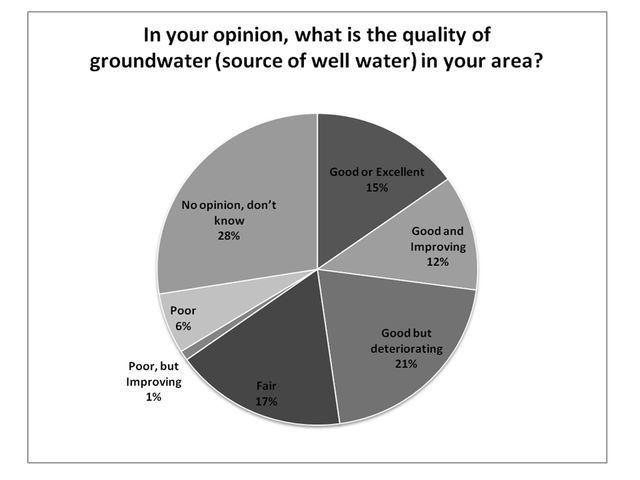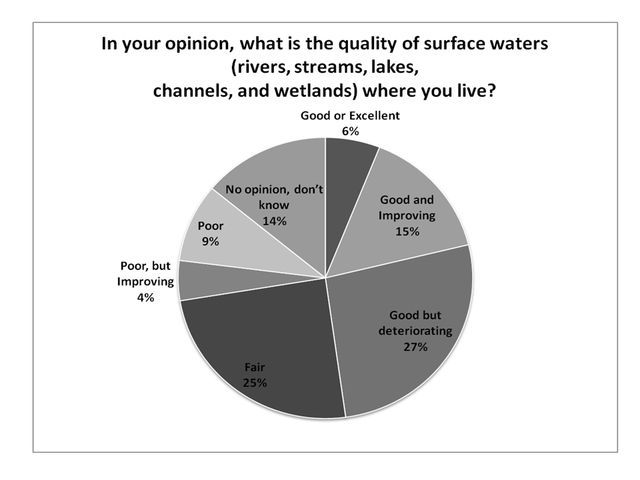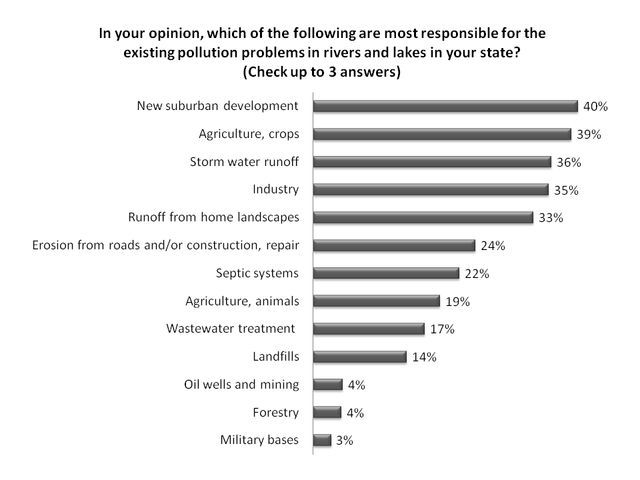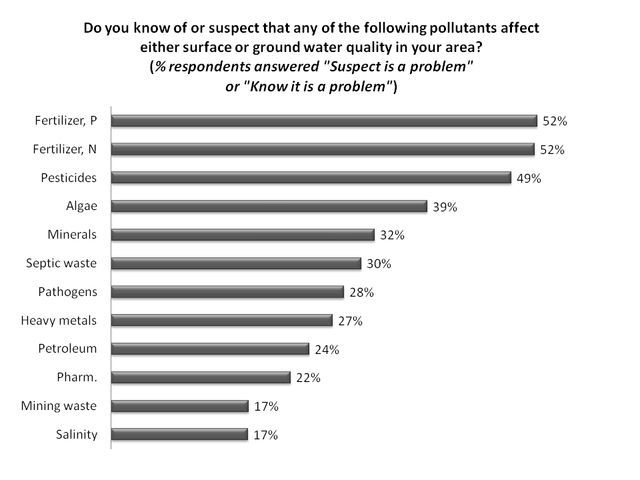Acknowledgments
This project was funded by the United States Department of Agriculture (USDA), National Institute of Food and Agriculture, under agreement 2008-51130-19537, also known as the Southern Region Water Resource Project. The publication summarizes Florida results of a national project conducted by Robert Mahler, Professor of Soil and Environmental Sciences at the University of Idaho. The project (report number SR-WPE-1) was supported in part by the Southern Region Water Policy and Economics program team led by Michael D. Smolen, Oklahoma State University; Leeann DeMouche, New Mexico State University; and Donn Rodekohr, Auburn University. Damian Adams, University of Florida, and Alyssa Dodd, Department of Environmental Resources Management (Palm Beach County, Florida), were instrumental in the development of this survey. The authors also would like to acknowledge the editorial suggestions for this publication by Lisette Staal, Carol Fountain, and Travis Prescott, University of Florida.
Introduction
This publication summarizes the results of a public survey about the quality of surface water and groundwater resources in Florida. Thirty-nine percent of the survey respondents believe that surface water quality in Florida is either poor or fair; and among those who believe that the surface water quality is good, 55 percent think that it is deteriorating. Although caution should be taken when generalizing survey results for Florida's population as a whole, these results imply that protecting and improving surface water quality should continue to be a priority for Florida's state and regional agencies. When asked about groundwater quality, 24 percent of respondents believe that the quality is poor or fair, 48 percent think that the quality is good, and 28 percent had no opinion or did not know. The percent of respondents who did not know / had no opinion about surface-water and groundwater quality is especially high among those respondents who have lived in Florida less than five years. This result implies that outreach efforts and Extension programs focusing on Florida's natural resources and the sustainability of these resources should target in particular those Florida residents who recently have moved to the state.
2008–2009 Survey of Public in Florida
This publication is one in a series describing a survey of Florida residents about water resource issues. The purpose of the survey titled Water Issues in Florida was to examine Florida residents' awareness and attitudes about water quality and quantity issues and the strategies to protect water resources.
The survey was designed by researchers at the University of Idaho, University of Florida, Florida A&M University, and other cooperating institutions within the United States Department of Agriculture's Southern Regional Water Program.
The survey was mailed to 1,154 randomly selected Florida households in the fall of 2008 and spring of 2009; 523 households completed and returned the survey (45.5% response rate). The majority of survey respondents had at least a high school diploma (97%), were male (68%), and were at least sixty years old (60%). Most survey respondents resided in cities with populations of at least 25,000 residents (76%), had resided in Florida for at least five years (90%), and resided in Florida year-round (89%). In comparison with total Florida population, the survey respondents were comprised of a larger proportion of male, older, and more educated respondents (Table 1). Such differences between the total Florida population and the sample of the survey respondents indicate that survey results may be affected by a non-response bias (i.e., people who responded to the survey may be different from those who did not). As a result, survey results may not accurately reflect the opinion of the state population as a whole (more information about the non-response bias can be found in EDIS publication PD008 by Glenn Israel [1992]). Unfortunately, non-response bias is typical for mail surveys (Scott and Overton 1977).
What Survey Respondents Think about the Quality of Groundwater
Groundwater is water found beneath the land surface, between soil particles, and in the fractures of bed rocks (Hornsby 2003). Florida's vast groundwater resources provide more than 90 percent of Florida's drinking water needs (FDEP 2008), and feed Florida's springs, rivers, streams, and lakes.
We asked survey respondents to rate the quality of groundwater (sources of well water) in the area where they live. About half of the respondents (48%) believed that the quality of groundwater was good (good or excellent, good and improving, or good but deteriorating) (Figure 1). Only one-quarter of respondents (24%) believed that the water quality was poor, poor but improving, or fair. However, groundwater quality protection and improvement should still be a priority for state and regional agencies since 21 percent of the respondents thought the quality was good but deteriorating.

More than one-quarter of the respondents (28%) did not know / had no opinion about the groundwater quality in the area where they live. This percent includes two categories of respondents: (1) those who are not interested in groundwater quality because they do not see this issue as important to them, and (2) those who want to learn more about groundwater quality but do not have access to, nor know where to get, relevant information. We hypothesize that the number of respondents from the first category is smaller among the Floridians who rely on private wells for their drinking water. For such respondents, groundwater quality may have a direct impact on their health and the health of their families, so they should have more interest in learning about groundwater resources. Statistical analysis (chi-square test, 99% confidence level) confirmed our hypothesis: only 12 percent of the respondents who reported using private water supply systems did not know / had no opinion about groundwater quality in their area. This percent was significantly higher (29%) among the respondents on public supply systems.
We also used statistical analysis (chi-square test, 99% confidence level) to examine whether the percent of respondents who had no opinion about groundwater quality depended on the number of years the respondents had lived in Florida. The analysis showed that 44 percent of the respondents who reported they had moved to Florida less than five years ago did not know / had no opinion about groundwater quality. For comparison, 26 percent of the respondents who lived in Florida five years or more did not know / had no opinion on the issue. For recent residents of Florida, it may be more difficult to find information about groundwater quality, so this category of Florida residents should be especially targeted by outreach and Extension programs.
We found that responses depended on the sex of the respondents. Specifically, only 6 percent of female respondents thought that groundwater quality is good or excellent (in comparison with 20% among male respondents), while 45 percent of female respondents did not know / had no opinion on the issue (compared with 20% among male respondents) (chi-square test, 99% significance level). Responses also depended on the age of the respondents: while 20 percent of respondents aged 60 years and over thought that groundwater quality is good or excellent, only 8 percent of respondents between the ages of 30 and 50 years old agreed. Twelve percent of respondents between the ages of 30 and 50 years old thought that groundwater quality is poor (in comparison with 6% among respondents older than 60) (chi-square test, 99% significance level). No statistically significant difference was found among responses from people with different educational levels. Since, on average, respondents of the survey are older and are more likely to be male (in comparison with the total Florida population), it is believed that the percent of people who thought the groundwater quality was excellent may be lower, and the percent of people who had no opinion or who thought the quality was poor may be slightly higher than indicated by the survey results.
What Survey Respondents Think about the Quality of Surface Water
Surface water includes water in channels, gullies, creeks, rivers, and lakes. Surface water bodies are familiar to Floridians as water supply sources, recreational attractions, transportation routes, and habitats for the state's abundant fish and wildlife populations.
In the survey, we asked respondents about the quality of surface-water bodies (rivers, streams, lakes, channels, and wetlands) in the area where they live. Only 21 percent of respondents thought that water quality was good or excellent, or good and improving. Two-third of respondents (65%) believed that the water quality was poor, poor but improving, fair, or good but deteriorating (Figure 2). Although caution should be taken when generalizing the survey results to Florida's population as a whole, such a large percentage of respondents indicates that many in Florida are concerned about the state of Florida's surface water.

Although only 14 percent of the respondents did not know / had no opinion about surface-water quality, statistical analysis (chi-square test, 99% confidence level) showed that this percent is significantly higher among respondents who moved to Florida less than five years ago (28%) compared to those who have lived in Florida 5 years or more (12%). We also found that the percentage of respondents who did not know / had no opinion is significantly higher among those with a high school education or less (24%) compared to those with higher educational levels (12%) (chi-square test, 95% confidence interval). Hence, natural resource outreach and Extension programs should emphasize delivering surface-water quality information to these two groups of Florida residents (i.e., residents who recently moved to the state and/or residents with lower educational levels).
We found that responses also depended on the sex of the respondents. Specifically, only 11 percent of female respondents thought that surface-water quality was good or good and improving (in comparison with 18% among male respondents), while 23 percent of female respondents did not know / had no opinion on the issue (compared with 10% among male respondents) (chi-square test, 99% significance level). No statistically significant difference was found among the responses from people of different age categories. Since, on average, the survey respondents were more educated and more likely to be male (in comparison with the total Florida population), the percentage of people who had no opinion about surface-water quality may be slightly higher than is indicated by the survey results.
We also asked respondents about the three causes most responsible for pollution problems in the rivers and lakes in Florida. The causes that were identified most frequently were new suburban development, agriculture (crops), and stormwater runoff (Figure 3). Industry and runoff from home landscapes also were included in the list of the three top causes by at least one-third of the respondents. This generally coincides with the conclusion by the FDEP (2008) that the surface-water quality problems in Florida mostly occur in the areas with major urban centers and dense populations, as well as in regions with intense agricultural and industrial use.

What Survey Respondents Think about Pollutants Affecting the Quality of Surface Water and Groundwater
About one-half of the respondents know / suspect that the surface-water or groundwater quality in their areas is affected by fertilizers (phosphorus and/or nitrogen) and pesticides (Figure 4). These perceptions are comparable to the water-quality monitoring data: nutrients are listed among the main causes of Florida's surface-water pollution problems, while pesticides and nitrates are among the pollutants that are most frequently detected in private wells (FDEP 2008).

Conclusions
This publication summarizes the results of a public survey about Florida water resources. The respondents were asked about the quality of groundwater (sources of well water) in their area, and the quality of surface waters (rivers, streams, lakes, channels, and wetlands) where they live. About half of the respondents believed that the quality of surface water and groundwater was good (specifically, good or excellent, good and improving, or good but deteriorating). However, half of those respondents thought that quality was good but deteriorating. Hence, Florida's state and regional agencies should continue focusing on protecting state water resources. We also found that the percentage of respondents who did not know / had no opinion about the quality of surface water and groundwater was higher among those who reported moving to Florida less than five years ago. Hence, effectively targeted programming may be needed to educate recent residents about Florida water resources.
Survey respondents differed in their demographic characteristics from the Florida population as a whole: they were older, more educated, and more frequently male. This difference may have influenced the results of the survey. Specifically, we believe that the number of people who had no opinion on surface-water and groundwater quality is higher than is indicated by the survey results.
References
FDEP. 2008. Integrated Water Quality Assessment for Florida: 2008 305(b) Report and 303(d) List Update. Florida Department of Environmental Protection, Tallahassee, FL (October). https://publicfiles.dep.state.fl.us/DEAR/DEARweb/WAS/Integrated_Report/2008_Integrated_Report.pdf. Accessed October 13, 2022
Hornsby, A.G. 2003. Groundwater: The hidden resource. SS112. Gainesville: University of Florida Institute of Food and Agricultural Sciences. https://edis.ifas.ufl.edu/ss112
Israel, G. 1992. Sampling issues: Nonresponse. PD008. Gainesville: University of Florida Institute of Food and Agricultural Sciences. https://edis.ifas.ufl.edu/pd008
Scott, A., and T.S. Overton. 1977. Estimating nonresponse bias in mail surveys. Journal of Marketing Research 14(3): 396–402.
U.S. Census Bureau. 2008. 2006–2008 American Community Survey 3-Year Estimates. S1501. Educational Attainment. Florida. United States Census Bureau, Washington, D.C. http://factfinder.census.gov/servlet/STTable?_bm=y&-qr_name=ACS_2008_3YR_G00_S1501&-geo_id=04000US12&-context=st&-ds_name=ACS_2008_3YR_G00_&-tree_id=3308&-_lang=en&-format=&-CONTEXT=st
U.S. Census Bureau. 2000. DP-1. Profile of General Demographic Characteristics: 2000. Census 2000 Summary File 1 (SF 1) 100-Percent Data. Florida. United States Census Bureau, Washington, D.C. https://www.census.gov/data/datasets/2000/dec/summary-file-1.html. Accessed October 13, 2022
USEPA. 2008. National Coastal Condition Report III. EPA/842-R-08-002, United States Environmental Protection Agency, Office of Research and Development/Office of Water, Washington, D.C. (December). https://www.epa.gov/sites/default/files/2014-10/documents/nccr3_entire.pdf. Accessed October 13, 2022